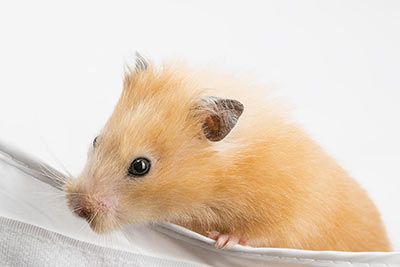Golden Syrian Hamster
Syrian Hamster Breed Profile
| Origin | Syria, Turkey |
| Genus | Mesocricetus |
| Scientific name | Mesocricetus auratus |
| Size | 4.8 to 6.2 inches (12-16 cm) |
| Color | See below: teddy, cream, dominant spot, satin, banded |
| Lifespan | 1.5 to 2 years |
| Personality | Can be lazy but generally docile, robust |
| How to keep them | Separately |

Characteristics
The Syrian hamster is also called the golden hamster. This is the main Syrian hamster from which all the other kinds are bred. The images in this article show the Syrian hamster in its “wild” form with characteristic rusty brown fur on the back and a light/white belly, dark cheek stripes, tulip-shaped ears and large, black eyes.
Syrian Hamsters Are the Biggest
Syrian hamsters are the biggest hamsters that you can keep as pets. They grow to between 4.2 to 6.2 inches (12-16 cm) long and weigh 2.8 to 5.3 ounces (80-150 grams). If that means nothing to you: they are around as big and as heavy as two to three Snickers bars. The European hamster can grow larger, up to 13 inches (34 cm) long, but isn’t suitable as a pet.
Colors
The Syrian hamster comes in various “editions”, colors and fur patterns. The colors have cool names like “chocolate”, “caramel” and “cinnamon”. They can be one color or multi-colored. You can get short-haired animals, long-haired “teddies” and hamsters with shimmering satin fur or even curly “rex” fur.
Syrian hamsters come in the following colors:
- Banded Syrian Hamster
- Cream Syrian Hamster
- Dominant Spot Syrian Hamster
- Satin Syrian Hamster
- Teddy Syrian Hamster
Species
Syrian Hamsters Aren’t the Only Hamsters in the Mesocricetus Genus
The hamsters listed above are just types of Syrian hamsters. There are still other hamsters that are part of the same genus and which are classed as separate species: the Turkish hamster (mesocricetus brandti), the Ciscaucasian hamster (mesocricetus raddei) and the Romanian hamster (mesocricetus newtoni). But these aren’t commonly kept as pets.
Which Hamster Should I Pick: A Syrian or a Dwarf Hamster?
If you’ve decided to get a pet hamster, you “only” have to decide whether to get a Syrian hamster or a dwarf hamster. Are there pros and cons or are all hamsters roughly the same? Syrian hamsters are actually different from the dwarves, especially when it comes to:
• Activity:
Syrian hamsters are much calmer and not as active as the lively Campbell dwarf hamster or the Roborovski dwarf hamster, which constantly flits about. So it might not be quite as exciting to watch a Syrian hamster. But a “slow-paced” hamster is easier to handle, e.g. if you have to pick it up or clean its toilet.
• Character:
Okay, so Syrian hamsters can be a little grumpy. But everyone has their bad days, right? They’re still the friendliest hamsters - compared to the dwarves - and don’t generally bite your fingers when you get close.
• Size:
Syrian hamsters are almost twice the size of dwarf hamsters. So they need larger cages and more space to exercise outside the cage.
Fun Facts
The “Syrian” hamster gets its name because it comes from the Syrian-Turkish border.
You can find out more about the Syrian hamster in the Syrian Hamster factsheet.











